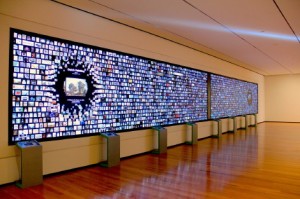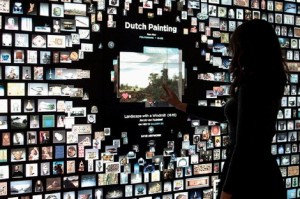Gail Chiasson, North American Editor
Visitors to the celebrated Cleveland Museum of Art and its Gallery One are engaging with displays and curating their own tours, thanks to Christie MicroTiles and Christie Interactivity Kit.
 Blending art and technology as part of an elegant $100 million renovation, Gallery One’s Collection Wall is a 40’ wide multi-touch screen comprising two 15-units wide by 5-units tall.
Blending art and technology as part of an elegant $100 million renovation, Gallery One’s Collection Wall is a 40’ wide multi-touch screen comprising two 15-units wide by 5-units tall.
Christie MicroTiles video walls use the Christie Interactivity Kit.
The 4-unit wide by 3-unit tall ‘Line and Shape’ MicroTiles video wall with another Interactivity Kit is located in Studio Play, Gallery One’s early (childhood) learning zone.
Inspiring visitors and motivating the younger, tech-savvy demographic to explore the museum’s thousands of works including Pablo Picasso masterpieces, the Collection Wall allows up to 16 people to interact simultaneously with the wall using RFID tags on iPad stations.
The results they create also suggest further topics of interest. Visitors can personalize and build their collections, curating their own tours on the iPad using the museum’s ArtLens app.
A ‘Line and Shape’ wall lets up to three children simultaneously draw lines or shapes. The content management software then finds and displays similar shaped artwork from the museum’s collection, encouraging participants to see shapes in everyday life.
When Christie MicroTiles debuted, Doug Fortney of Zenith Systems, project integrator, learned how the museum could eliminate the need to replace projector lamps and not worry about color matching even for a display that runs all day. He was particularly interested in the maintenance since he wanted to install a video wall directly into the architecture.
“When I learned from Bob Christopher (Central Regional Manager, Business Products Fixed Install, Christie) you could repair each tile just by removing its screen – that got really interesting because, as an integrator, we’re always thinking about not only building something, but maintaining it.” says Fortmry. “It was very important to come up with a sustainable design. Part of what is so attractive about MicroTiles and Interactivity Kit is the components are modular, not very big, and everything can be repaired quickly. We don’t really have access to the back – so we needed to be able to fix anything from the front.
 “The big things that appealed to us are no lamps to replace, the 65,000-hour half-life of the LEDs, the technology in the MicroTiles that helps them maintain a uniform color across all the tiles, and the great black levels. Trying to make this art look really spectacular requires fantastic black levels and the MicroTiles give us the blacks we want. The art really ‘pops’ on it and adds to that ‘wow’ effect because the black levels are so good.
“The big things that appealed to us are no lamps to replace, the 65,000-hour half-life of the LEDs, the technology in the MicroTiles that helps them maintain a uniform color across all the tiles, and the great black levels. Trying to make this art look really spectacular requires fantastic black levels and the MicroTiles give us the blacks we want. The art really ‘pops’ on it and adds to that ‘wow’ effect because the black levels are so good.
“The other piece that became very important was learning about Christie Interactivity Kit at another trade show – because this wall was going to be interactive. Until that point, we were looking at another product for the touch interface because we needed a very high accuracy performance where you touch a small piece of art and manipulate it.”
Adding to the experience, Fortney and his team also wrote software that generates a dead zone around the initial touch, preventing accidental touches such as a piece of loose clothing from creating an unintentional result.
Powered by Baanto ShadowSense, the Christie Interactivity Kit adds multi-touch interactivity to any large-format, rectangular digital display. It lets multiple users interact simultaneously with a video wall with the resolution and speed needed to support finger-based gestures such as flicking, pinching, rotating and scrolling. Scalable, and designed in pieces, Christie Interactivity Kit attaches to a video wall perimeter and is configurable into 84 different sizes with no drivers or manual calibration of sensors or cameras required.
Fortney said the displays are becoming the iconic symbol of the gallery, calling them a unique application of technology and a beautiful thing to see. He is not alone. The Cleveland Museum of Art and its Christie digital displays are earning enthusiastic reviews from staff, visitors and media.
“From everybody it has been an ‘Oh wow! This is beautiful.’ No one has seen anything like it,” Fortney says. “From a distance, the wall has a real ‘wow factor’ and then a completely different ‘oh wow’ experience when you go up and interact with it because now it is right in your face. Rather than simply a traditional static museum, you have interactivity that helps people see, appreciate, and understand the art that is at the museum. The technology draws this new crowd here and they want to experience it.”






Follow DailyDOOH